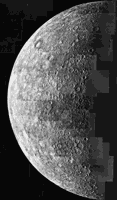Quick Links:
Sun, Moon, Mercury, Venus, Earth, Mars, Jupiter, Saturn, Uranus, Neptune, Pluto, More Planets, Comets
Mercury represents the mind and intellect, and rules Gemini, sign of duality, also Virgo, and has its exaltation in Aquarius. Mercury is an airy planet, associated with all forms of communication and the in-flow and out-flow of intelligence. Its position indicates how your mental function will be expressed, and where techniques and skills are available to you.

Sun-scorched Mercury is only slightly larger than Earth's Moon. Like the Moon, Mercury has very little atmosphere to stop impacts and it is covered with craters. Mercury's dayside is super heated by the Sun, but at night temperatures drop hundreds of degrees below freezing. Ice may even exist in craters. Mercury's has an egg-shaped orbit. Mercury is an extreme planet: the smallest, the densest, the one with the oldest surface, the one with the largest daily variations in surface temperature, and the least explored. Mercury, like Earth, has a global internal magnetic field. Mars and Venus do not. Less than half of the surface of Mercury has been imaged by a spacecraft.
| Planet | Mass (10x24 kg) | Volume (10x10 km3 | Equatorial radius (km) | Polar radius (km) | Mean density (kg/m3) | Surface gravity (m/s2) | Surface acceleration (m/s2) | Escape velocity (km/s) |
| Mercury | 0.3302 | 6.083 | 2439.7 | 2439.7 | 5427 | 3.70 | 3.70 | 4.3 |
| Earth | 5.9736 | 108.321 | 6378.1 | 6356.8 | 5515 | 9.80 | 9.78 | 11.2 |
| Name | Orbital Period | Sidereal rotation |
| Mercury | 88 Days | 59 Days |
Discoverer: Unknown
Discovery Date: Prehistoric
Distance from Earth Minimum (10x6 km) 77.3
Maximum (10x6 km) 221.9
Apparent diameter from Earth
Maximum (seconds of arc) 13.
Minimum (seconds of arc) 4.5
Maximum visual magnitude -1.9
Mean values at inferior conjunction with Earth
Distance from Earth (10x6 km) 91.70
Apparent diameter (seconds of arc) 11.0
Surface pressure: ~10-15 bar (0.001 picobar)
Average temperature: 440 K (167 C) (590-725 K, sunward side)
Total mass of atmosphere: <~1000 kg
Atmospheric composition:
42% Oxygen (O2)
29% Sodium (Na)
22% Hydrogen (H2)
6% Helium (He)
0.5% Potassium (K)
possible trace amounts of
Argon (Ar)
Carbon Dioxide (CO2)
Water (H2O)
Nitrogen (N2)
Xenon (Xe)
Krypton (Kr)
Neon (Ne)
(The atmosphere of Mercury is essentially a vacuum.
Compositional values are not well constrained, values from
"Mercury", Vilas, Chapman, and Matthews, eds., University of Arizona Press, 1988)
Technical Information courtesy of Nasa
Quick Links:
Sun, Moon, Mercury, Venus, Earth, Mars, Jupiter, Saturn, Uranus, Neptune, Pluto, More Planets, Comets